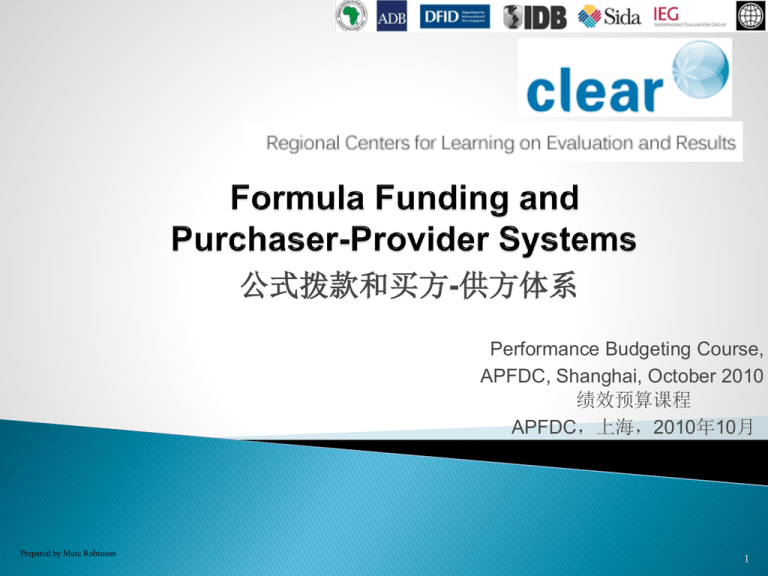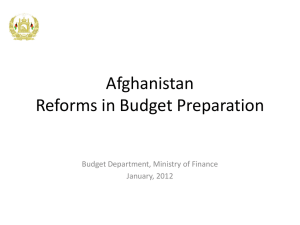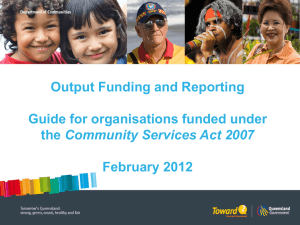公式拨款和买方-供方体系
advertisement

公式拨款和买方-供方体系 Performance Budgeting Course, APFDC, Shanghai, October 2010 绩效预算课程 APFDC,上海,2010年10月 Prepared by Marc Robinson 1 引言 Two mechanisms for creating tighter funding/results link 建立更紧密的拨款和结果关联性的两种机制 ◦ Formula funding (FF) 公式拨款 ◦ Purchaser-provider (PP) 买方-供方 ◦ PP is a type of FF system 买方-供方是公式拨款体系的一种 Explain how these systems work 解释这些体系如何运行 Potential advantages to boost performance 提升绩效的潜在优势 Limitations 局限 ◦ Risk of perverse effects 产生负面效果的风险 ◦ Appropriate for only some types of government services 只适合某些类型的政府服务 ◦ Not techniques for government-wide budgeting 并非政府范部门的预算技术 2 公式拨款 3 接种疫苗的例子 Suppose unit cost of vaccinations is $25 假设接种疫苗的单位成本是25美元 Use unit cost of vaccinations in budget 在预算中采用接种疫苗的单位成本 ◦ Provide $1m vaccination funding to ministry 给政府相关部门提供疫苗拨款1百万美元 ◦ Indicate that expect 40,000 vaccinations 指出预期接种疫苗4万例 Makes performance expectations explicit 明确绩效预期 ◦ Like setting a performance target 如 设置绩效目标 ◦ Hold ministry accountable if fewer vaccinations 如果接种疫苗数少于预期,则让政府相关部门承担责任 4 公式拨款 Funding determined by formula 由公式决定的拨款 ◦ Based on, e.g., population, services provided, size of geographic area served 由人口、提供的服务和服务的地理区域大小等因素决定 ◦ Partially or wholly formula-based 部分或全部基于公式 Performance budgeting form of FF: 公式拨款的绩效预算形式 ◦ Formula links funding to results 公式将拨款和结果联系起来 Outputs or outcomes 产出或结果 ◦ And aim is to promote better results 目的是改善结果 Quantity x Unit Cost = Budget 数量 x 单位成本=预算 5 设计拨款公式 Different funding for different outputs 针对不同的产出给予不同的拨款 ◦ E.g. in university funding systems 如 大学拨款体系 ◦ Funding for science students different from that of humanities students 给理科学生的拨款不同于给文科学生的 ◦ Science much more resource intensive 理科要求更多、更密集的资源 Simple unit cost funding formula 简单的包含单位成本的拨款公式 ◦ Funding = output quantity x unit cost 拨款=产出数量 x 单位成本 Rarely as simple as that 很少如此简单 6 公式中的复杂性 Danish “Taximeter” system example 丹麦“出租车计价器”的例子 Course completion payments 行程结束支付款项 ◦ The results-based element 结果导向的要素 ◦ Vary with course types 随行程类型而变化 But other elements in funding system: 但拨款体系中的其他要素 ◦ Building and maintenance component 创立和维护的部分 ◦ Collective expenses (overheads) component 共有开支部分 ◦ Supplementary grants for small institutions 给小型慈善机构的补助 ◦ And a range of other payments… 以及一系列其他支付 7 买方-供方体系 8 大学拨款的例子 Universities funded for courses provided 大学因其提供的课程被拨款 ◦ As main funding mechanism 作为主要的拨款机制 ◦ E.g. $3000 per year for full time law student 如,全脱产法学学生每年拨款3000美元 ◦ $5000 per year for science student 理科学生每年拨款5000美元 Money linked to students actually taught 拨款资金额与实际被教的学生数相关 ◦ Not to numbers planned to be taught 而非计划要教的学生数 Incentive for output delivery & efficiency对完成产出和效率的 激励 ◦ High cost universities suffer 大学承担的高昂成本 ◦ Incentive to actually deliver planned outputs 对实际完成计划产出的激励 9 买方-供方体系的定义 Type of cost-based FF system 基于成本的公式拨款体系的类型 Funding for outputs actually delivered 按实际完成产出拨款 ◦ Not for planned outputs 不是计划产出 Usually funding for outputs, not outcomes 通常按产出而不是按结果拨款 Government purchases outputs 政府采购的产出 ◦ From provider agency 从供应部门来看 Main funding source 主要拨款来源 ◦ Not just supplementary bonus funding 不只是补充性的奖励基金 Incentive to boost output quantity 对提高产出量的激励 10 价格、利润和损失 Agencies paid prices for outputs 部门为产出支付价格 ◦ Might also be some non-output funding 可能也有一些无产出的拨款 ◦ E.g. separate capital funding 如,独立投资基金 Loss if agency’s unit costs > price 如果部门单位成本大于价格,则亏损 ◦ Incentive to improve efficiency 对改善效率的激励 Payment only for outputs produced 只为实际产出支付 ◦ Less output means less funding 较少的产出意味着较少的拨款 The closer prices are to efficient cost 价格越接近有效成本 ◦ The greater the pressure for efficiency 改善效率的压力就会越大 11 成本、价格和损失 Price 价格 Unit cost 单位成本 X quantity 数量 Total revenue 总收入 如何拨款 How to fund? Loss 损失 Total costs of production 总生产成本 12 买方-供方体系属于市场机制 The principle of simple markets 简单市场的原则 ◦ Purchasers pay prices to arms-length suppliers 买方支付价格给独立供应商 ◦ Revenue only earned for products delivered 只因提交产品而赚取的收入 ◦ Loss if products aren’t supplied 因产品不能提供而遭受的损失 ◦ Loss for inefficiency 因低效而遭受的损失 PP also called quasi-market mechanism 买方-供方体系也被称作准市场机制 13 基于病例组合而进行拨款的例子 Payment to hospital for outputs 对医院产出的拨款 Based on Diagnostic-Related Groups (DRGs) 以诊断关联群为基础 Prices for each DRG category 对每个诊断关联群种类的支付价格 ◦ $x for hip/knee replacement 置换髋关节或膝关节的价格为x美元 ◦ $y for heart transplant 心脏移植的价格为y美元 Funding depends on output 拨款取决于产出 Losses if costs exceed DRG price 如果成本超过诊断关联群的价格,则会带来损失 Market (purchaser-provider) principle 市场(买方-供方)原则 Replaces “block” budgets 代替“整体”预算 ◦ Funding like that of ministries 像政府部门那样的拨款 基于病例组合拨款的目标 Improved efficiency 改善效率 ◦ Pressure to deliver services at lower cost 以低成本提供服务的压力 ◦ Increased specialization 提高专业化 Timeliness of treatment 治疗的及时性 ◦ Only earn money when treatment provided 只有提供治疗才能赚钱 Patient choice 患者的选择 ◦ Funding follows the patient 拨款遵照病人的选择 Equitable funding of hospitals 医院的公平拨款 ◦ Relative to block budgets 相对于整体预算 ◦ Where funding poorly related to output 整体预算中的拨款与产出的关联度较小 对病例组合拨款的担忧 Skimping 克扣行为 ◦ Cost-cutting at expense of quality 以牺牲质量为代价削减成本 ◦ E.g. use of inferior but cheaper prostheses 如使用廉价劣质的假肢 Dumping 推卸行为 ◦ Avoiding expected higher cost patients 避免接诊费用预期较高的病人 ◦ Result of heterogeneity 异质性结果 Creaming 揩油行为 ◦ Actively selecting expected low cost cases 主动选择预期低成本的病例 ◦ Heterogeneity again 也是异质性 Considerable professional resistance 相当多专业性的阻力 但是,结果良好 Surprisingly few adverse consequences 令人惊奇的是,很少有负面影响 Important role of medical ethics 医德的重要作用 ◦ Practitioner power over treatment choices 医生选择治疗方案的权力 Public hospitals not profit-seekers 公立医院不以追求利润为目的 ◦ Loss-avoiders 损失规避方 Quality assurance systems 质量保证体系 ◦ Peer review, accreditation etc 同行审查,认证等 No right to refuse to treat patients 无权拒绝治疗病人 Addition of quality element to payment? 支付款项之外的质量因素? 应计产出预算 PP model for whole government budget 适用于全部政府预算的买方供方模式 ◦ Applied to ministries, not just NPIs 适用于政府部门,不仅是非盈利机构 ◦ New Zealand, mid-1990s 新西兰,20世纪90年代中期 ◦ Australia, late 1990s 澳大利亚,20世纪90年代晚期 ◦ Now abandoned... serious failure 现在已经放弃...严重失灵 Ministries receive prices for outputs 政府部门接受产出价格 ◦ Govt to act as a “purchaser” of their services 政府部门充当服务买方 ◦ Budget documents or supporting material to state output deliverables用于说明可交付产出的预算文件和相关材料 18 应计产出预算 Aim to introduce payment for results 目的是保证根据结果来支付 ◦ Revenue only earned when outputs delivered 只有当产出交付时,才会获得税收 ◦ Quarterly invoicing in Victoria, Australia 澳大利亚维多利亚州的季度拨付 Aims to set price = efficient cost 目的是让价格等于效率成本 ◦ Simulate operation of a competitive market 模拟竞争市场的运作 ◦ Efficient cost supposed to be determined by market comparators, market testing etc... 效率成本应该由市场参比和市场测试等来决定 19 应计产出预算系统的目标 Efficiency pressure on ministries 提高政府部门效率的压力 ◦ Pressure to deliver outputs 交付产出的压力 ◦ Pressure to reduce costs to efficient level 将成本降低到有效水平的压力 Facilitate competition with private sector suppliers 促进与私人部门供应商的竞争 ◦ Ministries would be treated exactly like external suppliers 像对待外部供应商一样对待政府部门 ◦ Tenders would be held on equal footing 政府部门与私人部门供应商平等地进行投标 ◦ Would loose the work if the private sector could supply more cheaply 如果私人部门能供给更便宜的产品和服务,政府部门将放松控制 20 系统严重失灵 Unworkable for many services 该系统对许多服务不适用 ◦ Police, defence, fire services, foreign affairs etc 警察、国防、消防、外交等 Never succeeded in basing prices on efficient cost 从来没有能够依照有效成本设定价格 ◦ Too difficult to determine 设定价格的难度太大 ◦ Required detailed research 需要详细的研究 ◦ Still difficult if no market comparator 如果没有市场参比,依然很困难 21 公式预算和买方-供方体 系可以有效运作的情况 22 异质性服务 Services where unit cost varies greatly 单位成本变化较大的服务 ◦ Because of tailoring of service to customer/case characteristics 因为根据具体顾客或情境而定制服务 FF/PP can manage some heterogeneity 公式拨款/买方-供方体系能控制某些异质性 If average unit cost is stable 如果平均单位成本稳定 ◦ Some clients/cases cost more than others 有些顾客/情境耗费成本比其他的多 ◦ But it averages out 但是达到平均水平 ◦ Approximately true for hospital services 医院的服务大约就是这样 But many public services with severe heterogeneity 但是许多公共服务具有严重的异质性 ◦ No stable average unit cost 平均单位成本不固定 ◦ Can’t apply a cost-based funding formula 不能运用基于成本的拨款公式 23 临时能力服务 Example of fire services: 消防服务例子 ◦ ◦ ◦ ◦ Unpredictable demand for services 服务需求无法预料 Must be responded to immediately 必须立即作出响应 Spare response capacity maintained 维持一定备用响应能力 Relation between funding and services actually provided is therefore weak因此拨款和实际提供服务之间的关系较弱 Can’t fund on output formula 不能按产出公式拨款 Many services like this in government 许多政府服务都属于这种情况 ◦ Insurance-type services 保险型服务 24 什么领域适合运用公式拨款和买方-供方体系? Selective rather than general application 选择性的而不是一般性的应用 Apply only to right types of programs 只应用于合适的项目类型 ◦ Relatively standardized services 相对标准化的服务 Complexity involved in setting formula 设置公式时涉及的复杂性 ◦ Argument for gradualism and selectiveness 对渐进主义和选择性的争论 ◦ Focus on one or two major services areas 集中关注一或两个主要服务领域 ◦ Rather than immediately introducing in many areas 而不是立即引入许多领域 25 结论 FF and PP valuable performance budgeting tools 公式拨款和买方-供方体系是宝贵的绩效预算工具 Should be selectively applied 应该有选择地应用 Technically demanding to implement 实施的技术要求比较高 Developing countries 发展中国家 ◦ Need to be particularly selective 特别需要有选择地应用 ◦ Very gradual approach to use of these tool 以渐进的方式使用这些工具 26








